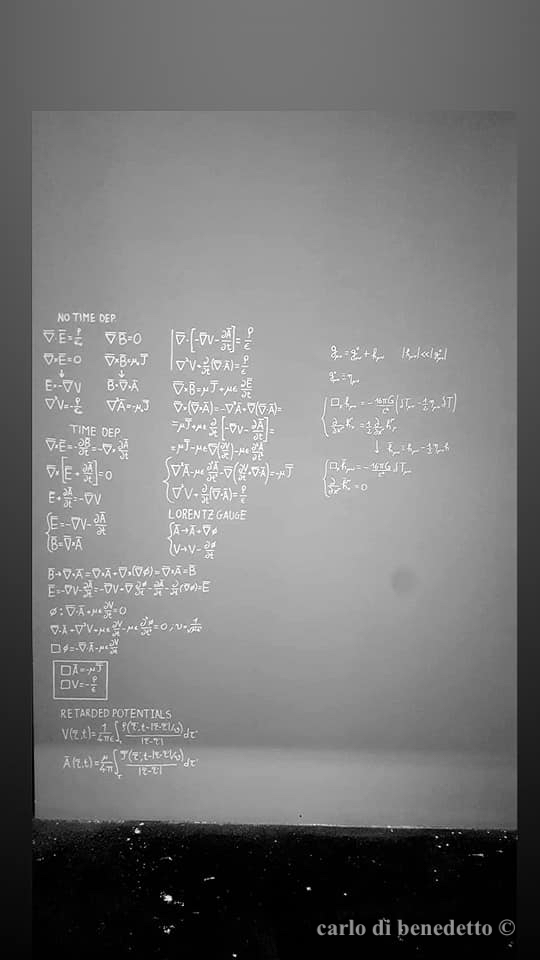LA FISICA IN UNO SCATTO
Competition edited by the Social Media Manager of the Physics Department of the University of Rome "Tor Vergata", Dr. Alice Aldi and promoted by the Physics Department of the University of Rome "Tor Vergata".
This page collects the twelve winning photos relating to the twelve themes dealt with in the first edition of the competition that connects photography and physics.

Winner ph: Possanza Fabio ©
I. For a handful of ASTRI
Curiosity: the Sun is a yellow dwarf (spectral classification G2 V). This denomination, however, does not concern the actual color of the sun, but is rather linked to its mass (1 solar mass) and its surface temperature (5777 K). The yellow / orange coloring of the Sun is a phenomenon essentially due to the earth's atmosphere which, depending on the height of the Sun in the sky (also combined with specific meteorological conditions), carries out a selection between the various wavelengths that make up the visible spectrum ( to which the human eye is sensitive) of solar radiation through the process of optical diffusion. However, as evidenced by various "photographs" in specific bands of the electromagnetic spectrum, the Sun emits radiation along the entire electromagnetic spectrum. As paradoxical as it may seem, the Sun is a good approximation of a well-known ideal object, the black body. The latter is called "black" because it absorbs all the radiation incident on it (absence of reflection) but, due to the law of conservation of energy, it is forced to re-emit it all without any distinction.

Winner ph: De Gasperis Giancarlo ©
II. The VISIBLE SPECTRUM, the collector of colors
Curiosity: The visible spectrum is a part of the electromagnetic spectrum that covers the wavelength range ~ 700 nanometers (red) - ~ 400 nanometers (violet). Compared to the entire electromagnetic spectrum, it is a very small interval, but one that gives living beings like us unforgettable emotions and shows. We are very lucky to have eyes among our "experimental apparatuses", which allow us to reveal this very colorful part of the electromagnetic spectrum. In our eye the real color detector is the retina, which behaves like a photographic film suitable for receiving both black and white and color impressions. It is made up of a large number of light-sensitive cells that differ in: "rods" and "cones". The light impulses received by the cones and rods are transmitted to the brain via the optic nerve. Rods, unlike cones, are not sensitive to color. In fact, when you are in a situation of good brightness, the cones are the most active part and allow normal color vision. While in low light conditions the most active part are the rods, which in this case allow the image to be processed by the brain, which, however, is deprived of the sensation of color. Our eye reaches its maximum sensitivity around the 555 nanometer wavelength which corresponds to yellow-green.

Winner ph: Ferrari Beatrice ©
III. Try to stop TIME
Curiosity: In physics, equilibrium is a concept that recurs often. Depending on the circumstances where this situation occurs, equilibrium together with its most appropriate definitions characterizes a physical system in a "privileged" state where all its properties no longer depend on the passage of time, it does not evolve, therefore it is often considered the most appropriate condition to be able to investigate and define some intrinsic properties of the system itself. Therefore, considering "the equation" balance = absence of time, it can be said that in physics it is not appropriate to think of time in its absoluteness, but rather in its relative being. Time in physics is rather a measure of an interval between a physical system with certain characteristics and its evolution. There are very high precision instruments to measure these time intervals, such as atomic clocks which are so called because they use the oscillations of a particular atom (electronic transitions between energy levels in atoms) as their "metronome." These clocks are used for example. in the most common satellite navigation satellites in orbit around the earth.

Winner ph: De Gasperis Giancarlo ©
IV. Lair for CHAOS!
Curiosity: In physics, determinism is a coveted concept since it provides "security" in describing the evolution and behavior of a physical system. Using a mathematical tool known as differential equations, the latter enriched by certain initial conditions, regulate the temporal evolution of a phenomenon. The possible resolution of these equations leads to a complete knowledge of the system, for each successive instant of time. But it must be said that, not in all physical systems and not for all initial conditions, of course, the situation is simple enough to be solved with satisfaction and infinite deterministic accuracy. Among the systems for which a similar scheme can be implemented are for example the motion of celestial bodies under the action of gravity and the periodic oscillations of a pendulum. In the first case, the so-called two-body problem such as the study of the motion of a planet around the Sun conducted by solving the differential equations based on the law of gravity (neglecting the small interactions with other planets), is quite simple to deal with and is for more deterministic. Already for the problem of the three bodies, Henri Poincaré, proved that it does not admit approximate solutions valid for an arbitrarily large time and for all the initial conditions, therefore it admits solutions far from being deterministic. This is due to the fact that in the problem of the three bodies some trajectories come into play from the behavior that today we define precisely chaotic, that is characterized by a strong dependence on the initial conditions: if the starting state of a system with these properties is also only slightly modified, very relevant effects can be produced in the state of arrival, or the evolution of the system can be totally revolutionized. Therefore, already in this second case, there is no total "security" and certainty about how the physical system will evolve over time. Another field of physics where chaos occurs is in fluid dynamics. In fact, in the definition of turbulent regime we have that the motion of a fluid in which the viscous forces (resistance to sliding) are not sufficient to counteract the forces of inertia: the motion of the resulting fluid particles occurs in a disorderly manner, completely three-dimensional with non-deterministic characteristics. To define if a system is in turbulent regime, we can refer to the Reynolds number.

Winner ph: Di Benedetto Carlo ©
V. I have an EQUATION to tell you
Curiosity: Equations are the language with which we are able to describe nature, trying to disclose all its mysteries. They allow us to communicate concepts in their most dry being, that is, devoid of any influence induced by linguistics or dialectics. Diophantus of Alexandria, an ancient Greek mathematician, was an expert on equations. In fact, a class of equations that look for only whole numbers as solutions are called Diophantine equations. In addition, Diophantus had the following epitaph written on his tomb, which, when turned into an equation, returns, as a solution, an integer that is none other than his age.
This sepulcher contains Diophantus and how much was the time of his life with admirable art illustrates you. Young boy stayed for a sixth, and for him to darken his chin with a beard, another twelfth had to wait. After this, another sixth passed before he found the woman to lie with, and in the fifth year of the union a beautiful baby was born. Alas, the unfortunate heir lived only half of his paternal age; he fell a cruel and sudden death. His father mourned him for the four years he survived, before finally closing his years count.
X / 6 + X / 12 + X / 7 + 5 + X / 2 + 4 = X
X =?

Winner ph: Aldi Alice ©
VI. In search of the lost STRINGS
Curiosity: String theory is now a theory that has been heard of at least once. This is because of one thing we are sure, “it arouses mystery thanks to its charm”. The phrase is often attributed to string theory, it is the "theory of everything", a statement that is not easy to bear and in fact still today is among the theories most questioned and under pressure. String theory finds its birth in the early sixties, where numerous physicists, thanks to increasingly powerful particle accelerators, were witnesses almost every day (so to speak) of the discovery of new particles, which go by the name of Hadrons. Hadrons are "bound states" of elementary particles called quarks which are held together by strong interaction through the perpetual exchange of the associated gauge bodons, the Gluons (which act as a glue, as the English term suggests). In the general family of the Hadrons, we find for example the Proton and the Neutron, particles that populate the nuclei of atoms, which in turn are formed by three quarks and therefore not defined as elementary particles. String theory initially aimed at explaining at a theoretical level "the hadronic spectrum", that is this growing myriad of new particles and therefore also providing prediction tools. This strong interaction between quarks, we wanted to parameterize with an object called string. History wanted that, the theory that best breathed with the experiments was the Quantum Dynamic Chromium (QCD in English), in fact today the theory of QCD is used to investigate hadronic spectra. But string theory was (and is) too well constructed to be brutally dismissed. In fact, it resurrected because it was realized that these one-dimensional vibrating strings (strings) are able with their vibrations to justify the presence of the most disparate particles, including the notorious Graviton (the quantum, or particle, associated with gravitational force) . And here the phrase "the theory of everything" came in straight, because whether you like it or not, to date string theory is the only theory that manages to contain all the known perhaps at the same time (Strong, Electromagnetic and Weak) and Gravity. The world of strings is a strange way, populated by open strings that end on hyperplanes called Brane, closed strings that travel undisturbed through Brane and Omega-planes (a kind of mirrors). Objects, which "live" in a space-time with a dimension greater than four. In short, the world of strings is comparable to an Indiana Jones adventure.

Winner ph: Pelusi Francesca ©
VII. MAGNETIC attraction
Curiosity: The property that some minerals possess, namely that of attracting iron filings, such as Magnetite, were already known in the seventh century BC. The name Magnetite was inspired by the Greek city of Magnesia which, thanks to the presence of several deposits of this mineral, gave the name "magnetism" to the phenomenon observed. In general, a magnet is defined as a material that exhibits magnetic properties. The set of experimental data leads us to hypothesize that the constituent elements of the magnets are the "magnetic dipoles", ie objects characterized by the presence of two poles of opposite sign (positive pole and negative pole), through which the magnetic interaction can manifest itself as an attractive or repulsive phenomenon depending on which pair of poles of the respective magnets is being made to interact. In many respects, magnetism does not differ from the behaviors linked to purely electrical phenomena, if not precisely for the unproven presence of the so-called "magnetic monopoles", which would be nothing more than the analogue of the single positive and negative charges present in the phenomena electrical. The existence of these magnetic monopoles was theorized by physicist Paul Dirac in 1931 while conducting his studies on reconciling classical electrodynamics with quantum mechanics. The thing that makes them important in addition to their hypothetical pure existence is that, following Dirac's studies, they would be able to justify another fundamental property of matter: the quantization of the electric charge, that is, the fact that in nature the electric charge it always appears in the form of an integer multiple of an elementary electric charge, that of the electron (excluding the sign). To date, several experiments are hunting for these fundamental objects, such as experiments conducted on the ground with particle accelerators and experiments with probes in space that search for traces directly or indirectly.

Winner ph: Ceci Giulia ©
VIII. The fanatic of SYMMETRY
Curiosity: In nature, symmetry is a golden ally since it allows you to generate preferential configurations where the system has certain characteristics, such as being in a state of minimum energy, or of less energy expenditure to maintain that given configuration stable. . In short, we know that nature is the master of savings! Consequently in physics, symmetry is a very important concept since it allows a physical system to be studied, compared, modeled, hypothesized, etc. The presence of symmetries is connected to the presence of the so-called quantities conserved or preserved by the system, which therefore constitute intrinsic properties of the system, properties that define that system unequivocally and which can therefore be exploited to demonstrate the validity of certain others. assumptions or as a solid point from which to start or refer in the development or study of a new theory, for example. There are several categories of symmetries: discrete, continuous, global and local. The choice of the category depends on the type of physical system that has been examined. The most famous theorem concerning the quantities conserved by symmetries is the "Noether's theorem", German mathematics. In the same way, in addition to the preservation of symmetries, the "breaking" of symmetries also plays a very important role in nature! For example, if the SU (2) XU (1) group of the electroweak interaction had not broken down to the U (1) _em (electromagnetic) group through the Higgs mechanism, today in the standard model of particles, we would not have been able to explain the mass of some fundamental particles nor in the presence of massless photons (symmetry U (1) _em) and massive bosons Z and W (+/-).

Winner ph: Giuliani Giovanni ©
IX. I'll give you a bundle of PHOTONS
Curiosity: In physics, but especially in particle physics, we often talk about particles (elementary or not) in the singular. In reality, when carrying out an experiment, it is more correct to speak of particle beams, that is, a set of innumerable particles of the same type that travel together very close together. This beam must have very specific characteristics, depending on the type of experiment you want to do, but in general you cannot ignore the need to have a well collimated beam, that is a flat wave front (given the wave nature of the particles ), very concentrated that wants to mimic the collision of a "single particle" by exploiting the "multi-particle" statistics to obtain as many interactions as possible with the target (another beam and / or fixed target such as a sheet of material). To collimate the beams, tools called collimators are used. The beams of photons (light) in particular were used for example in Einstein's experiment on the photoelectric effect as well as in the Compton experiment, from which the Compton effect or Compton scattering took its name. Photon beams are widely used in the study of the interaction between electromagnetic radiation and materials. One of the most common objects characterized by the presence of a beam of photons with very specific characteristics is the Laser, which in addition to being composed of a source that emits electromagnetic waves, there is an area called optical cavity where the electromagnetic waves after numerous reflections come out well concentrated.

Winner ph: Aldi Alice ©
X. The LATTICE, master of replication
Curiosity: In physics, there are not a few research addresses where the lattice is the protagonist. Among these we can in fact mention both the physics of matter and the physics of elementary particles.In the case of physics that studies the structure of matter, the study of lattices is among the first steps that are carried out when a given material must be characterized. The reticular structure, that is the geometric distribution that the atoms of the material in question follow, associates specific behaviors and properties to the material itself. An example of this is the distribution of carbon atoms in graphite and diamonds. In graphite the carbon atoms are arranged according to hexagonal meshes on planes linked by very weak forces, which guarantee, for example, the sliding of the pencil on the sheet, leaving traces of the stroke. While in the diamond the tetrahedral distribution of the carbon atoms guarantee strength and stability to the mineral in question. In the case of elementary particle physics, the calculation techniques based on the "lattice" are very advanced and precise. These techniques provide that the spacetime in which the elementary particles propagate is not represented by a continuous fabric, but is discretized in cells of a certain size, which is called a reticular step. The power of these techniques is that at the end of the calculation it is possible to extract the results by making them the limit of continuity, or by sending the reticular pitch to zero, restoring the usual continuity of spacetime. These techniques are particularly used in theories such as QCD (quantum chromodynamics), the theory that describes the strong interaction, where the protagonists are quarks and gluons, fundamental building blocks for hadronic particles such as nucleons.

Winner ph: De Gasperis Giancarlo ©
XI. Do you want to "SCATTER"?
Curiosity: The scattering or diffusion processes are protagonists in most of the research fields in physics. It starts with simple studies of classical mechanics, and then moves on to optics, radiation-matter interaction, particle physics, string theory, astrophysics, etc ... With the concept of scattering we want to investigate how in general a process in which the protagonist is the "collision" of "something with something" takes place and can be described theoretically and experimentally observed. Whatever the "ingredients" involved in the collision, the result has always reserved great amazement and enormous amounts of information to be analyzed in order to fully understand the event that was witnessed. The scattering processes have a prominent importance since they are the "theater" where the interaction between physical systems can be studied. And what is more important in interaction physics? After all, physics is built on the fact that everything that happens is connected both to the concept of "cause" and "effect" and that "every action corresponds to a reaction". So the interaction, and its manifestation, will always be the center of our favorite puzzle, the Universe. Just as every coin has two sides, if on the one hand we have the interaction on the other we can say that we have scattering processes. To cite a famous example where scattering was the "tool" of investigation used to understand how all this that we actually are, we recall the experiments conducted by Geiger and Marsden under the direction of Ernest Rutherford. Thanks to these experiments it was deduced that the atom has a nucleus at its center. Thomson's model was therefore discarded, which predicted a “full” atom like a panettone and the Rutherford atomic model was confirmed. This result was obtained thanks to the study of the collision between the alpha particles placed by a source (eg. Radio) and the nuclei of the gold atoms of the target foil.

Winner ph: Romanelli Andrea ©
XII. I never understood the GRAVITY of the thing
Curiosity: Gravity is the only force that we "macroscopic particles" are able to experience. Basically finding a way to reconcile ourselves with the nature of the gravitational force, while staying in balance, is among the first things we learn. But, despite being the only force to which we have macroscopically access as "sensitive tools", unlike other fundamental forces such as the electromagnetic force, weak and strong, we still do not have a complete picture that can describe it in the round in any situation. , starting from the simplest ones (falling off a step) to the most extreme ones (studying the inside of a black hole). Gravity is a long-range force, which not only manages the order and movement of macroscopic bodies in the universe but itself manages the entire space-time fabric, that is, its geometry (curved over large distances). Thus managing the space-time fabric, its presence is everywhere, but its effects are detectable and predominant only under certain conditions. For example, in the physics of elementary particles the gravitational contribution is the most suppressed, therefore it can be neglected as well as being able to approximate spacetime as perfectly flat. In cosmology and astrophysics, on the other hand, considering the effects of gravitational force (thanks to general relativity) to estimate the effective distance of stars, galaxies, quasars, is very important. The gravitational force is predominant, as mentioned, when it comes to black holes. Very very massive objects, dense and difficult to observe. Black holes are the final stage of the evolution of some stars, a stage that is still the subject of in-depth studies today since the dividing line between studying them without the use of quantum mechanics or with the tools of the latter, is very thin.